Established in the heartlands of the United States, Kansas is home to a variety of fascinating caterpillars. With around 137 native and non-native species, these creatures thrive in the state’s diverse ecosystems. Caterpillars are the larval stage of moths and butterflies, emerging from eggs laid by the adults. Their diversity varies based on season, location, and habitat, with more variety in the eastern parts and wooded areas compared to the western regions and open spaces.
How Are Caterpillars Classified?
Welcome to the enchanting realm of caterpillars! These remarkable creatures are classified based on unique physical attributes such as body shape, leg count, and the presence of spines. Caterpillars possess three primary segments: the head, thorax, and abdomen, each playing a vital role in their complex existence. With their distinct leg arrangements and defensive spines, these creatures exhibit an extraordinary level of complexity. Moreover, caterpillars display significant variation in behavior. Some lead solitary lives, while others remain active either during the day or at night.
A Caterpillar’s Metamorphosis
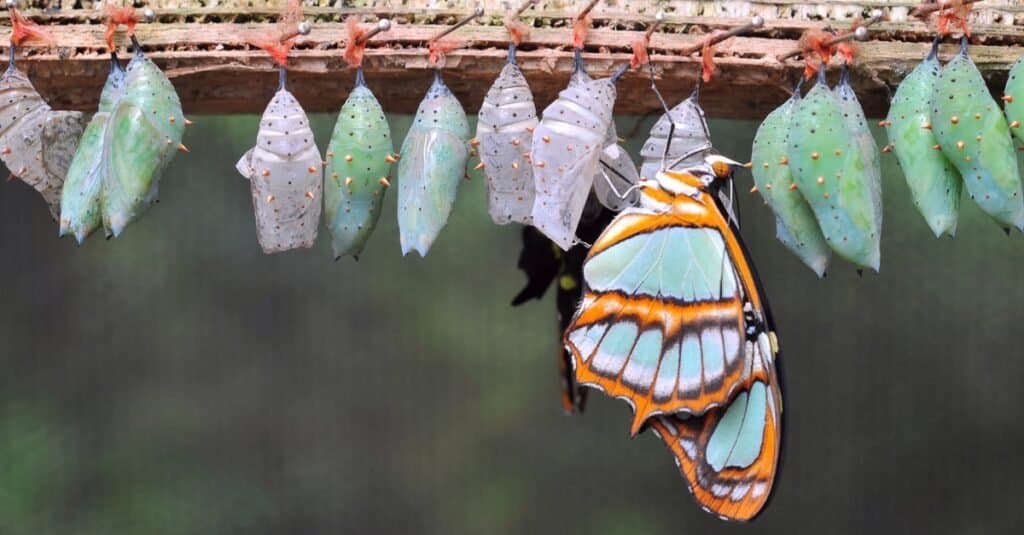
Caterpillar metamorphosis is a remarkable transformation that captivates observers with its awe-inspiring journey.
©Ksenia Ragozina/Shutterstock.com
The fascinating process by which a caterpillar undergoes a remarkable transformation into an adult butterfly or moth is known as metamorphosis. During this intricate journey, meticulously regulated hormones play a vital role in dictating various stages of metamorphosis. These hormones not only prompt the caterpillar to cease feeding and undergo molting but also guide its transition into the pupa stage. Moreover, they intricately orchestrate the development of specific organs and tissues in the adult phase, ultimately resulting in the beautiful and delicate creatures we admire.
Moth or Butterfly?
Butterflies and moths belong to the insect order Lepidoptera, derived from the Greek term “scale-winged”. These organisms share common traits, such as possessing four wings adorned with minuscule scales. Nonetheless, notable distinctions exist between these two taxonomic groups.
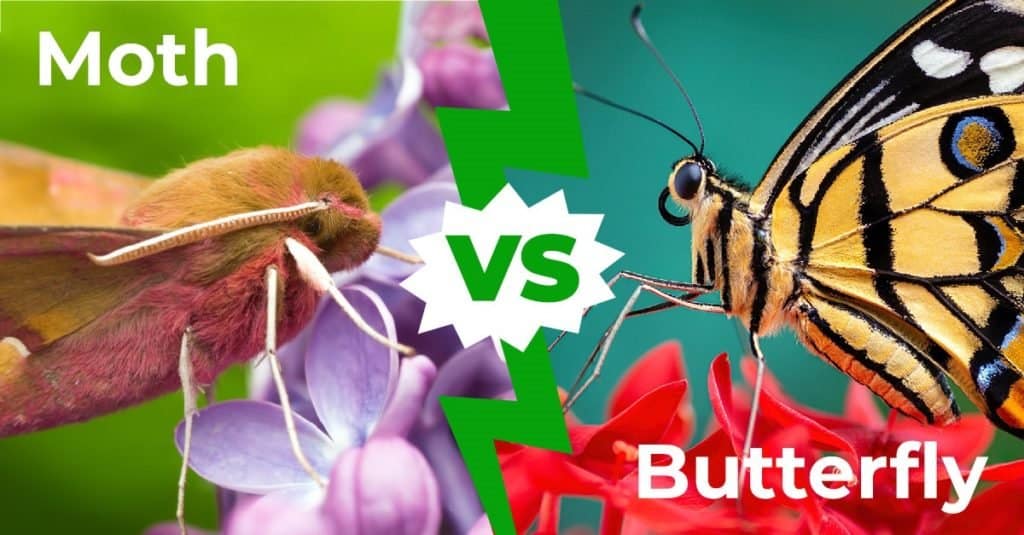
Butterflies and moths exhibit distinct differences in wing positioning. Upon resting, butterflies fold their wings vertically over their backs, whereas moths tend to keep their wings flat or spread out horizontally. Notably, their antennae also offer contrasting features: butterflies possess slender and elongated antennae with club-like tips, while moths display feathery antennae with a thicker, comb-like appearance. Additionally, butterflies employ vibrant hues to attract mates and deter predators, whereas moths generally showcase more subdued tones to blend in. While butterflies are primarily diurnal, remaining active during the day, many moths are nocturnal. It is important to note, however, that exceptions exist, such as the luna moth.
Common Caterpillars Found in Kansas
The ecosystems in Kansas are home to a plethora of caterpillar species, comprising both native and non-native moths and butterflies. Within this state, a diverse array of these captivating creatures can be found, with certain species exhibiting a higher prevalence. Below, you will discover an extensive compilation of frequently encountered caterpillars in this remarkable region.
1. Banded Woolly Bear Caterpillar (Pyrrharctia Isabella)
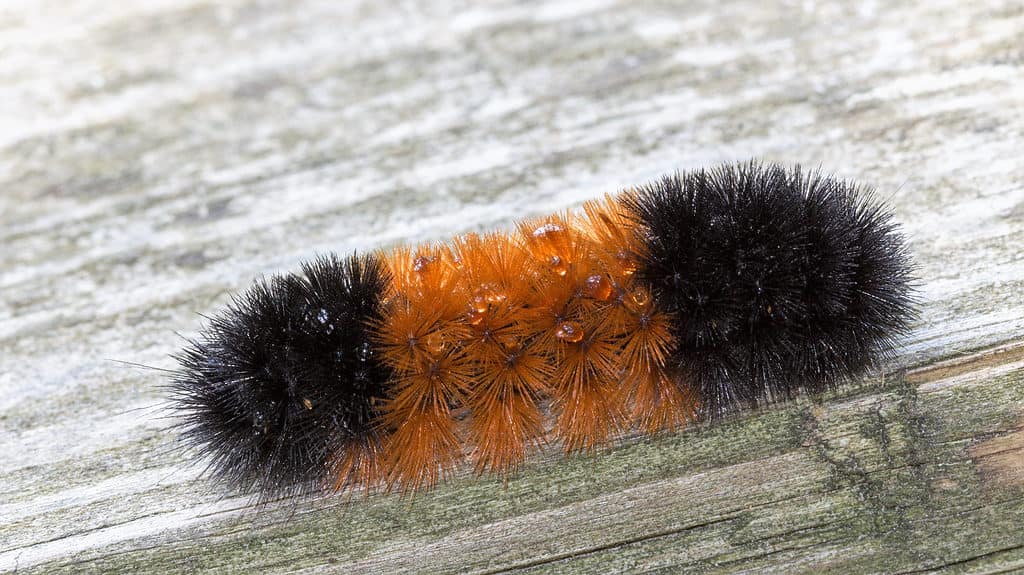
Woolly bear caterpillars are famous for their dense hairs.
©Kimberly Boyles/Shutterstock.com
The banded woolly bear caterpillar (Pyrrharctia isabella) is renowned for its dense hairs. These 1 to 2-inch caterpillars feature a black head and tail with a brown or orange band in between. Belonging to the Erebidae family of moths, they protect themselves using short yet sturdy hairs. Their diet comprises various plants, and come spring, they undergo a marvelous transformation into splendid moths. Isabella tiger moths, the adult form of these caterpillars, exhibit lovely wings in shades of yellowish-orange and cream, adorned with black spots. Despite their short lifespan of about a week, they dutifully lay eggs to ensure the continuity of the next generation of caterpillars.
2. Eastern Tent Caterpillar (Malacosoma americanum)
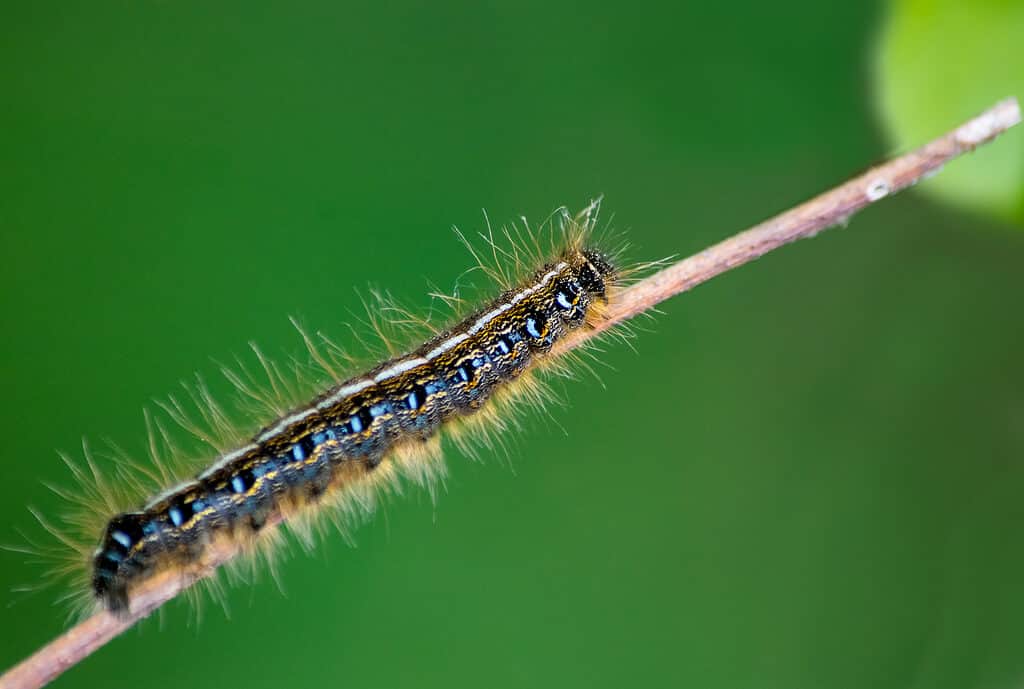
These voracious caterpillars primarily consume the foliage of various tree species such as apple, cherry, and crabapple.
©K Quinn Ferris/Shutterstock.com
The eastern tent caterpillar undergoes a one-year life cycle characterized by distinct stages. The female moths deposit their eggs in clusters that adhere to tree branches, enveloped in a protective substance referred to as spumaline. In April or May, the eggs hatch, revealing black caterpillars donning white hairs. To safeguard themselves during their growth process, they construct silken tents. These tents serve as a protective haven as the caterpillars progress through five distinct developmental stages, which are known as instars. At the culmination of their growth, the caterpillars enclose themselves within a cocoon, transitioning into the pupal stage. Throughout the winter months, the pupae remain dormant, only to emerge as fully formed adult moths the following year.
3. Fall Webworm (Hyphantria cunea)
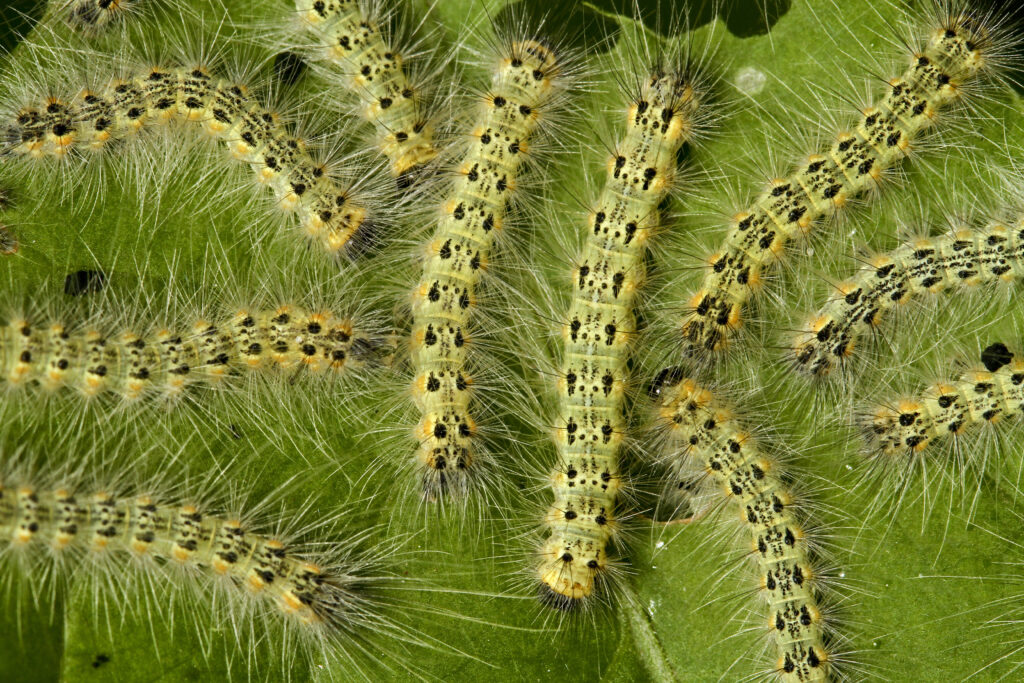
The fall webworm moth caterpillar creates its unique webs in the late summer and fall.
©Geza Farkas/Shutterstock.com
The life cycle of the fall webworm spans one year. Adult moths typically emerge in late July or early August and are characterized by their small size and white color, boasting a wingspan of approximately 1.5 inches. Female moths lay their eggs in clusters on the branches of host trees, which are covered with a durable, shellac-like substance called spumaline. These eggs hatch in the spring, typically in May or June. The juvenile caterpillars display a black coloration with red scoli, or bumps, adorned with tufts of long white hair. Their diet mainly consists of the leaves from various host trees, such as apple, cherry, and oak. As the caterpillars mature, they construct protective silken tents within branch crotches, effectively shielding themselves from potential predators and parasites.
4. Spicebush Swallowtail Caterpillar (Papilio troilus)
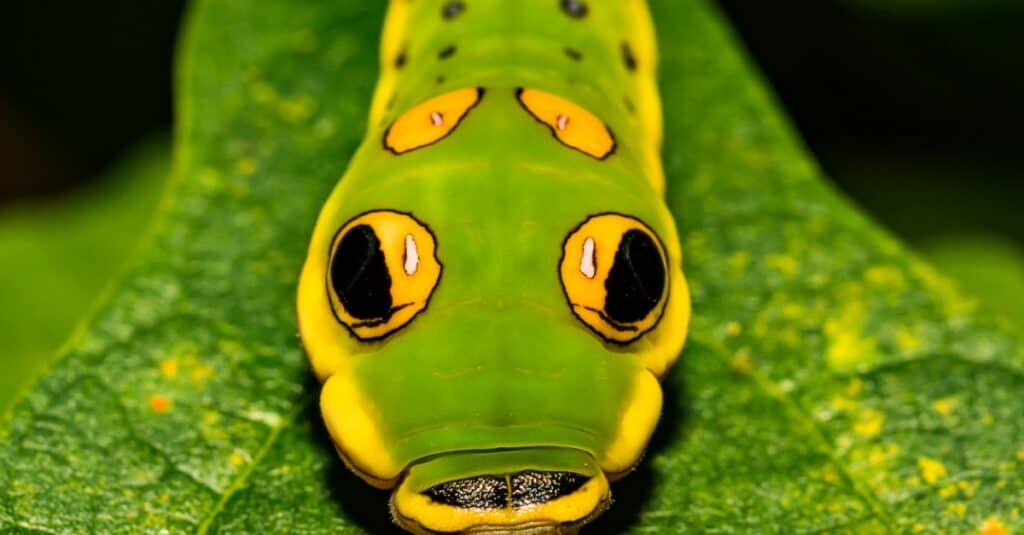
Caterpillars of spicebush swallowtails possess a distinct forked tail and a horn on their heads, growing up to approximately 2 inches in length.
©iStock.com/JasonOndreicka
The spicebush swallowtail caterpillar is found in Kansas, although it is a common butterfly species in the eastern United States, ranging from southern Canada to southern Florida and westward to Texas. However, its occurrence becomes less frequent as you move farther west from the Mississippi River. The caterpillar of the spicebush swallowtail is characterized by its vivid green color, adorned with black stripes and yellow spots. The spicebush swallowtail butterfly exhibits remarkable beauty with its wings displaying stunning hues of blue or green, accompanied by a wingspan of around 3 inches. This butterfly species remains active from May to October.
5. Pipevine Swallowtail Caterpillar (Battus philenor)

Pipevine swallowtail caterpillars have black bodies with vibrant orange spikes, giving them a distinct coloration.
©Sundry Photography/Shutterstock.com
The pipevine swallowtail caterpillar, found in Kansas, thrives in diverse habitats like forests and meadows. Its distinct black body and orange spikes set it apart, while its primary diet of pipevine plants results in toxin accumulation. This makes it unappealing to predators. During its two-week transformation inside a green chrysalis, it emerges as a vibrant blue and orange butterfly. With a lifespan from May to October, this species displays its striking colors as a warning. It plays a crucial role in regulating pipevine plant populations, and caution is advised due to the potential harm its toxins can cause.
6. Viceroy Butterfly Caterpillar (Limenitis archippus)
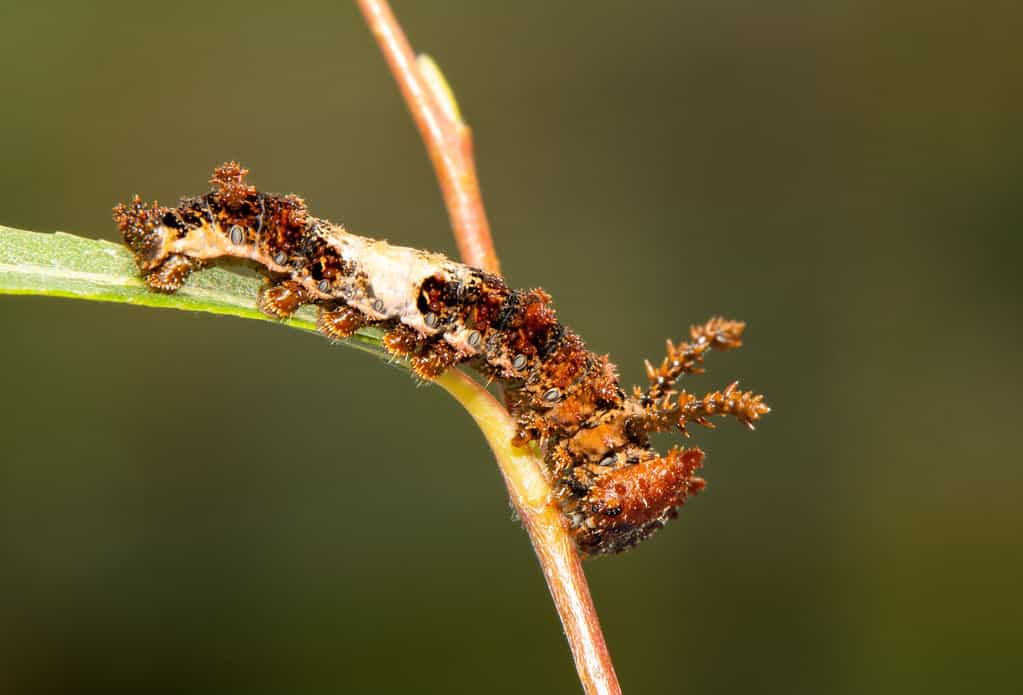
Viceroy butterfly caterpillars have a very unusual appearance.
©Sari ONeal/Shutterstock.com
The viceroy butterfly caterpillar is native to North America and is recognized for its defensive mimicry of the monarch caterpillar. It thrives in diverse habitats such as forests, meadows, and wetlands, primarily in the eastern United States and southern Canada. The life cycle of the viceroy butterfly is fascinating, comprising four distinctive stages: eggs, larva (caterpillars), pupa (chrysalis), and adult. The larva emerges from the egg within one week, whereas the astonishing metamorphosis into an adult butterfly takes place approximately two weeks after entering the pupal stage. Notably, the viceroy caterpillar feeds on the leaves of willows, poplars, and cottonwoods. Furthermore, this species showcases its migratory nature as certain populations embark on a southerly journey during the winter season.
7. Black Swallowtail Caterpillar (Papilio polyxenes)

This caterpillar devotes most of its time to consuming foliage while evading potential predators.
©Graphicato/Shutterstock.com
The diet of the black swallowtail caterpillar primarily consists of plants belonging to the carrot family (Apiaceae), including Queen Anne’s lace, parsley, and fennel. It may also consume rue, celery, dill, and occasionally other plant species. The black swallowtail butterfly inhabits diverse habitats throughout North America, such as fields, meadows, woodlands, wetlands, and gardens. The female black swallowtail strategically lays eggs on the undersides of host plant leaves, either individually or in clusters. As the eggs mature, they transition from a pale white color to a darker black hue. The caterpillar stage persists for approximately 2 to 3 weeks before undergoing pupation. Upon emerging, the adult black swallowtail butterfly displays a wingspan ranging from 2.76 to 3.9 inches, characterized by striking black and yellow wings.
8. American Dagger Moth Caterpillar (Acronicta oblinita)
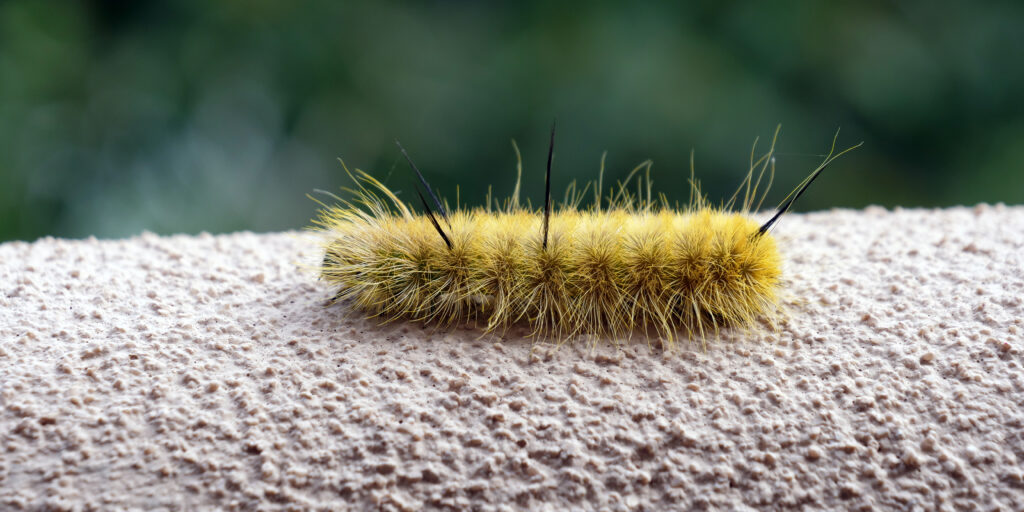
American dagger caterpillars are toxic and cause stinging when they’re touched.
©Martha Marks/Shutterstock.com
The American dagger moth caterpillar typically measures between 1.5 to 2 inches in length and displays a grayish-brown body adorned with distinctive black and yellow markings. Notably, the caterpillar possesses hairs that can cause skin irritation or rash development. American dagger moth caterpillars primarily feed on various plant species, including but not limited to apple trees, elms, willows, and grasses. However, their presence can prove detrimental to crops such as corn and cotton. During the winter season, these caterpillars undergo their pupal stage, taking refuge within the soil, and subsequently emerge as adult moths exhibiting a grayish-brown hue. The wingspan of these moths usually measures approximately 2.5 inches.
9. Cecropia Moth Caterpillar (Hyalophora cecropia)

The cecropia moth plays a vital role as a beneficial insect, actively contributing to pest control.
©K Hanley CHDPhoto/Shutterstock.com
The cecropia moth caterpillar thrives in a multitude of habitats, from forests and woodlands to suburban areas. This extraordinary species displays a diverse palate, feasting on trees like maple, birch, apple, and willow, all while undergoing five distinct developmental stages before transitioning into its pupal phase. Suspended by a delicate silk thread, the brown pupa patiently awaits its transformation into a magnificent adult moth, a mere two weeks later. Found predominantly in the eastern region of the state, these captivating caterpillars delight observers with peak sightings from May to June.
Poisonous Caterpillars Found in Kansas
Certain caterpillars found in the diverse state of Kansas possess a toxicity that serves as a clever defense mechanism against their predators. Popular among the species of caterpillars with this kind of defense are the well-known monarch caterpillar and the intriguing milkweed tussock caterpillar. Both of these caterpillars exhibit a fascinating dietary preference for the toxic milkweed plant. The toxins do not hurt the caterpillars, but they will if another animal tries to eat them.
| Ways Of Being Poisonous | Example / Description |
|---|---|
| Toxic body | Some caterpillar species have the amazing ability to consume poisonous plants and retain the toxins within their bodies. If these caterpillars are ingested by their predators, the toxins have the potential to cause illness. |
| Poisonous or venomous spines or hairs | These spines or hairs are commonly linked to poisonous glands. Upon contact, they detach and deliver the venom directly into the victim, causing immediate effects. |
| Poisonous or venomous liquid | Certain caterpillars possess a remarkable talent for producing toxic substances, which can be discharged from their mouths or rear ends. This potent liquid can cause skin irritation, intense burning sensations, and, in severe cases, blindness. |
It’s important to note that not all caterpillars with a poisonous appearance are toxic. When unsure about a caterpillar’s toxicity, exercising caution and refraining from physical contact is advised. Here is a list of some of the most toxic caterpillar species found in Kansas!
10. Monarch Butterfly Caterpillar (Danaus plexippus)

Astonishingly, monarch butterflies embark on a long journey to warmer climates, returning to their birthplace in the spring to start the cycle again.
©iStock.com/CathyKeifer
The life cycle of the monarch butterfly caterpillar is a captivating transformation. It starts with the female monarch carefully laying her eggs on a milkweed plant leaf. After about four days, a tiny caterpillar emerges. The caterpillar has special adaptations, including sharp spines for defense and the ability to easily molt due to its soft shell. Its diet primarily consists of milkweed, which contains toxins to protect it. Over two weeks, it grows rapidly, shedding its skin through molting. When it reaches a sufficient size, the caterpillar attaches itself and forms a protective shell, entering the pupa stage. Inside the shell, a remarkable metamorphosis takes place, leading to the emergence of an adult monarch butterfly.
11. Io Caterpillar (Automeris io)

The Io caterpillar has a visually captivating appearance.
©Donna Bollenbach/Shutterstock.com
Measuring 2 inches, the Io caterpillar possesses poisonous spines for self-defense. When sensing danger, the caterpillar releases venom composed of a mixture of proteins and alkaloids. This venom serves as a defense mechanism to protect itself. It can result in pain, inflammation, and occasionally, symptoms like nausea and headaches. These caterpillars thrive in diverse habitats, from lush forests to enchanting gardens. Their survival hinges on their extraordinary ability to consume a wide array of plants, including hackberry, willow, and mesquite. Pupation occurs during autumn, followed by the emergence of these magnificent creatures as moths in spring.
12. Puss Caterpillar (Megalopyge opercularis)

The puss caterpillar is a distinguished arthropod species well-known for its poisonous characteristics.
©Chase D’animulls/Shutterstock.com
Indigenous to the southern regions of the United States, this caterpillar possesses a plush and delicate body with tones of grayish-brown, accentuated by distinct black stripes. However, it is imperative to exercise caution when encountering the puss caterpillar due to the potential for painful stings. While not inherently aggressive, this caterpillar’s minuscule hairs can induce poisonous reactions upon contact, leading to symptoms such as burning, itching, swelling, and redness. In severe cases, individuals may also experience additional symptoms including nausea, vomiting, headaches, and respiratory difficulties.
13. Mourning Cloak Caterpillar (Nymphalis antiopa)

The mourning cloak caterpillar has black spikes.
©Massimiliano Paolino/Shutterstock.com
Mourning cloak caterpillars undergo a fascinating metamorphosis to transform into the mourning cloak butterfly. Adorned with tiny white hairs and red or orange markings on its dark body, this caterpillar exhibits a voracious appetite for plants such as elm and willow. Following five instars, it enters the chrysalis stage and emerges as a butterfly with beautiful iridescent black wings. This species thrives in lush deciduous forests with abundant foliage, displaying a distinct preference for such habitats.
14. Giant Leopard Moth Caterpillar (Hypercompe scribonia)
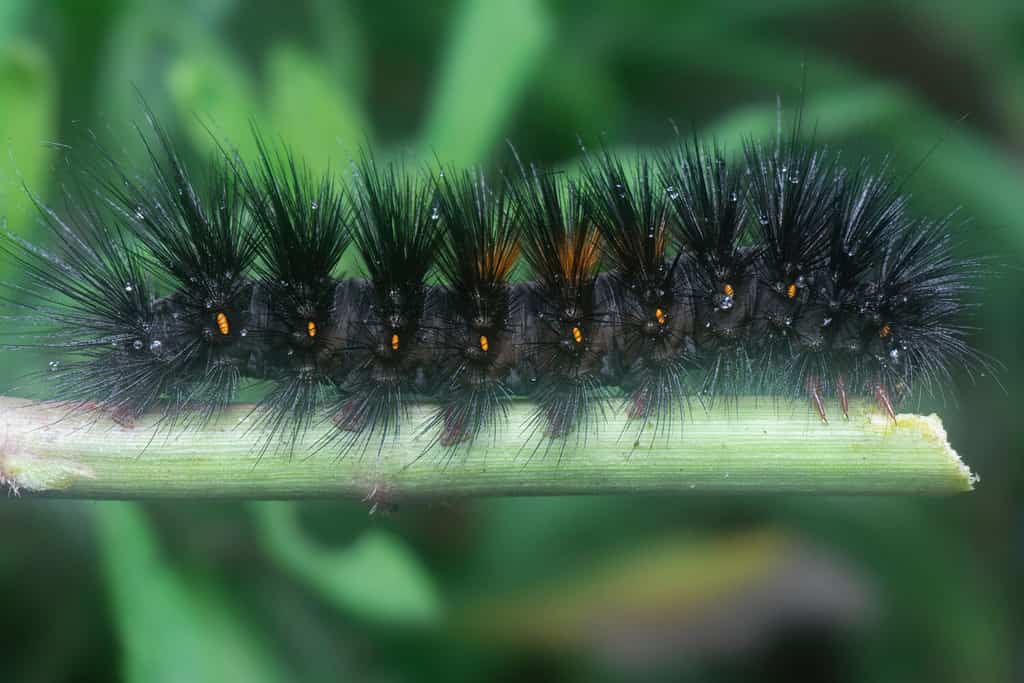
In Kansas, look for giant
leopard
moth caterpillars in wooded areas and gardens, particularly near cherry trees, during daylight hours.
©Young Swee Ming/Shutterstock.com
The giant leopard moth caterpillar is a vibrant species native to North America. It measures about 2 to 3 inches long and has a black body with distinctive orange and white stripes. Covered in long, spiky hairs, this caterpillar can cause skin irritation. It thrives in various habitats, including forests, woodlands, and gardens, and feeds on plants like cherry, dandelion, maple, orange, sunflower, violet, and willow. The caterpillar undergoes five instars before transforming into a chrysalis. After approximately two weeks, the adult moth emerges with a wingspan of around 3 inches.
15. Hickory Tussock Moth Caterpillar (Lophocampa caryae)

During the autumn season, the caterpillars undergo pupation, and the adult moths emerge in the spring.
©Stephanie Gelman/Shutterstock.com
The hickory tussock moth caterpillar is found in various habitats in Kansas, including forests, woodlands, and gardens. This prevalent insect features a white body adorned with black spots and white hairs (called setae), with tufts of black setae along the dorsal side and “pencils” at both ends. It is important to note that these setae can cause skin irritation and swelling upon contact. With an average length of approximately 1.7 inches, the hickory tussock moth caterpillar feeds on a variety of trees, such as hickory, ash, oak, elm, maple, and Virginia creeper. It undergoes one generation per year, with adult moths taking flight in May and June, while the caterpillars are present from July to September.
Summary of Non-Poisonous Caterpillars in Kansas
| Caterpillar Name | Scientific Name | Vegetation They Like to Eat |
|---|---|---|
| Woolly bear caterpillar | Pyrrharctia Isabella | Aspen, birch, elm, maple, oak, poplar, willow. |
| Eastern tent caterpillar | Malacosoma americanum | Apple, birch, cherry, elm, hickory, maple, oak, poplar, willow. |
| Fall webworm | Hyphantria cunea | Apple, ash, elm, maple, oak, poplar, willow. |
| Spicebush swallowtail caterpillar | Papilio troilus | Spicebush, sweetbay magnolia, tulip poplar. |
| Pipevine swallowtail caterpillar | Battus philenor | Pipevine. |
| Viceroy butterfly caterpillar | Limenitis archippus | Asclepias, dogbane, milkweed. |
| Black swallowtail caterpillar | Papilio polyxenes | Carrot, celery, dill, fennel, parsley. |
| American dagger moth caterpillar | Acronicta oblinita | Aspen, birch, elm, maple, oak, poplar, willow. |
| Cecropia moth caterpillar | Hyalophora cecropia | Birch, cherry, maple, oak. |
Summary of Poisonous Caterpillars in Kansas
| Caterpillar Name | Scientific Name | Vegetation They Like to Eat |
|---|---|---|
| Monarch butterfly caterpillar | Danaus plexippus | Milkweed. |
| Io Caterpillar | Automeris io | Aspen, birch, elm, maple, oak, poplar, willow. |
| Puss Caterpillar | Megalopyge opercularis | Ash, elm, hickory, maple, oak, poplar, willow. |
| Mourning Cloak Caterpillar | Nymphalis antiopa | Elm and willow. |
| Giant Leopard Moth Caterpillar | Hypercompe scribonia | Apple, elm, maple, oak. |
| Hickory Tussock Moth Caterpillar | Lophocampa caryae | Hickory, oak. |
The photo featured at the top of this post is © iStock.com/Janice Chen
Thank you for reading! Have some feedback for us? Contact the AZ Animals editorial team.







